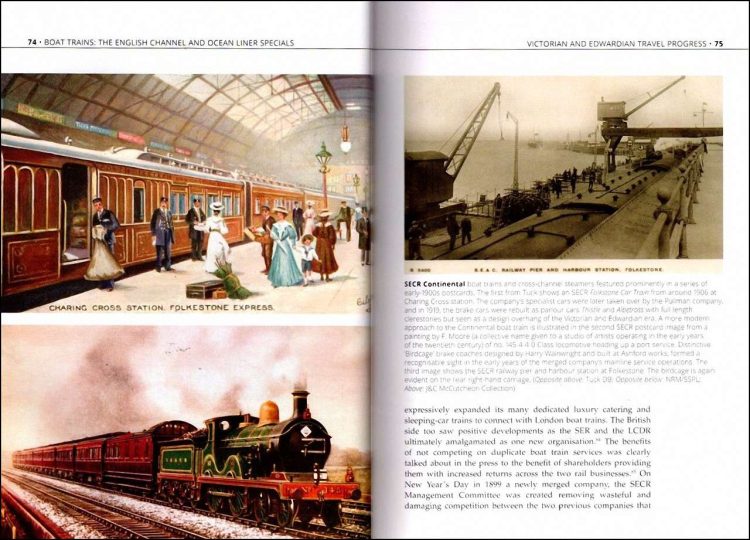This book tells the evolution of boat trains from the end of the nineteenth century to the present day. It covers not only trains that ran to connect with cross-channel ferries, but those that were often luxuriously appointed and carried international passengers to connect with Transatlantic liners.
Published in November 2020, this hardback book from publisher Pen & Sword and written by Martyn Pring measures around 17.78 cm x 24.77 cm, has 384 pages, and 119 colour and 118 black & white photographs, illustrations, and maps. It has a published price of £35.00 although at the time of writing it can be purchased from Amazon for £25.99.
As soon as I opened this book, I knew I was in for a treat as it has copies of many nostalgic posters superbly reproduced on quality glossy paper. It has six chapters arranged in a logical sequence. Chapter 1 describes progress made in travel during the Victorian and Edwardian eras, Chapter 2 tells of the golden age of travel in the inter-war years, and Chapter 3 highlights how international travel resumed after World War II.
In Chapter 4, the author discusses whether the age of boat trains has come to an end, Chapter 5 brings back many memories, with individual sections on the great continental express trains, including the Calais-Méditeranée Express, Côte d'Azur Rapide, the Rome Express; The Blue Train and Côte d'Azur Pullman Express, and the Mistral, as well as the Golden Arrow and Night Ferry. Finally, Chapter 6 pays homage to the Ocean Liner Special boat trains of the book's title, with sections on the special trains that ran to Liverpool's Riverside and Gladstone Docks, Southampton Docks, Plymouth's Millbay and Stonehouse docks, Bristol's Avonmouth docks, and Fishguard Harbour.
A Foreword by renowned railway author Paul Atterbury summarises the glamour that came with “boat trains” and sets the scene for what follows. That is soon clear in the Introduction, with a poster advertising travel between London's Euston station and Japan in 22½ days involving two ocean liners and dedicated boat trains.
An interesting section describes how faster and more stable twin-screw vessels replaced cross-channel paddlers at the end of the nineteenth century, resulting in a significant expansion in people travelling to Continental Europe.
As well as cross-channel ferries, many liners carried passengers from Britain around the globe. These all had one thing in common, which was the need to transport them between cities and the ports, for which rail travel was ideally suited, and which is described in detail in this well-illustrated book.
The pages below show that, even in the early 1900s, railways were promoting cross-channel travel, Postcards dating from 1906 on the left-hand page show trains of the South Eastern and Chatham Railway with special carriages that were the forerunner of Pullman carriages, whilst, on the right, the company's pier and harbour at Folkestone is the postcard's subject.

It is clear from the left-hand page below that cross-channel travel was being well-marketed, with the poster highlighting how many ferries there were in 1950 compared to 100 years previously. For many years, the “Golden Arrow” was Britain's most-famous boat train and was an example of good marketing as seen by the adornments on the locomotive at the top-right below. In steam days, the locomotive was emblazoned with the train's title crossed by a diagonal golden arrow on the smokebox, the Union flag and French flags on the buffer beam, and a large golden arrow adorning the side of the locomotive's boiler. The bottom picture shows how the value of advertising was lost in later years, as the train's name has been reduced to a nondescript headboard on the front of the electric locomotive.
As well as the Golden Arrow, there was a second cross-channel ferry, the “Night Ferry”. Unlike the Golden Arrow, Night Ferry carriages travelled throughout between London and Paris, including on board the cross-channel ferry. Striking advertisements extolled its virtues, with the poster at the top-left below full of nostalgia, compared with the one on the right, which is more functional.
Boat trains weren't only run in connection with cross-channel ferries, as many more special trains ran for transatlantic passengers. Whilst Southampton Docks was often the destination of these trains, the London Midland and Scottish Railway (LMS) also saw their benefit and ran special trains to Liverpool, using striking posters that nowadays exude nostalgia to advertise their availability.
Boat trains to Southampton Docks often carried headboards specific to the companies that owned the ships that they were destined for, such as the ones shown below, which no doubt are carrying passengers destined for Cunard Line ships.
This is a hefty book that takes the reader back to the more-glamorous days when travelling overseas was by ship, often preceded by a journey on a train that matched the superb décor of the ships. Express trains with names like “the Golden Arrow” and the “Night Ferry” that carried cross-channel passengers to the ferry ports may have found a place in popular fiction, but there were many more that were no less glamorous. The author has carried out a great amount of research to provide an eminently readable description of boat trains and how they came about. The book contains a large number of vintage posters that are superbly reproduced, allowing the golden age of travel to shine through. This book is much more than a book about trains, as it will appeal to ship enthusiasts, lovers of vintage travel posters, and anyone who is interested in travel in general. There surely cannot be a more comprehensive story of boat trains in a single book. A book full of fascinating information, exceedingly well produced, and great value for money. Highly recommended.
The book is available to purchase from Amazon and from Pen & Sword.
We would like to thank Pen & Sword for providing RailAdvent with a copy of the book for review.